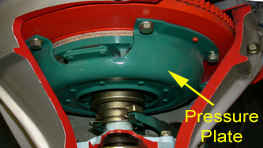
Description: The pressure plate contains a clutch plate, springs, cover and release fingers. This subassembly bolts to the flywheel, with the clutch disc sandwiched in between. Although there are two types of pressure plates, the spring-type and the diaphragm-type, the latter is used most often.
Purpose: The pressure plate, as its name implies, applies pressure to the clutch disc for the transfer of torque to the transmission. The pressure plate, when coupled with the clutch disc and flywheel, makes and breaks the flow of power from the engine to the transmission.
Maintenance Tips/Suggestions: Clutch chatter is a common symptom that may indicate a worn clutch, but this symptom could also be caused by oil leaking from the engine onto the clutch assembly, a poor flywheel surface, damaged pressure plate release levers, a sprung clutch disc hub and improper alignment between the engine and transmission. Another common clutch problem is clutch slippage. This can be caused by a variety of factors such as a damaged pressure plate, worn, binding or misadjusted linkage, incorrect clutch components, and even normal wear. A dragging clutch is the least common symptom and is just the opposite of slippage. Drag occurs when the clutch doesn't release at all, or releases only partially. Clutch drag is usually caused by a worn, binding or misadjusted clutch linkage. Drag can also be caused by air in the hydraulic clutch linkage, damaged pressure plate fingers, and binding of the clutch disc on the input shaft. To get to the heart of your car’s clutch problem, have Kirtec Auto Services road test your vehicle to confirm the symptoms you’re experiencing. It’s the best first step of a proper diagnosis.

